The average voter has been fooled. Locking up trees in national parks is a con. Blaming their demise on “climate change” is a lie. Excluding people who love and care for the environment is a travesty.
Tom Marland
Introduction
As we celebrate World Endangered Species Day on 19 May, I thought it timely this month to look closely at how species are faring in Australia, particularly in reserves authorities have established to protect them.
Many farmers that adjoin national parks constantly complain about the feral animals in the reserves that impact their productivity. Ryan Stone is an amateur ecologist who volunteers for the Queensland and Australian Museums in their research programs. After spending a few weeks cataloguing reptile species during the day and recording frog calls at night in Great Sandy National Park, he found introduced predators such as wild dogs and foxes had overrun the park. At one spot, Ryan counted 17 wild dogs in a pack moving through the park. He also saw a large wetland destroyed by pigs. Ryan’s story can be repeated in most national parks and reserves across the country.
We don’t hear about this aspect of monitoring in our reserves because the government, bureaucrats and environmental activists don’t want the public to know just how poorly managed our reserves are.
It is widely known in New South Wales that there has been a decline in biodiversity in national parks. The New South Wales National Parks and Wildlife Service (NPWS) admitted this in their 2021 zero extinctions report.
In response, NPWS announced, in October last year, the establishment of a network of seven feral predator-free areas across the state as part of a rewilding exercise. They aim to have 65,000 hectares free from feral predators. However, considering they manage over 7.5 million hectares, ensuring less than one per cent of the land they manage is free from ferals is hardly an achievement.
NPWS have been forced to do this work because private enterprise has achieved much better results in dealing with feral predators. For example, the Australian Wildlife Conservancy is a not-for-profit private landowner and land manager of nearly 13 million hectares. In just 30 years, they have successfully established an active reserve management program focussing on two things NPWS doesn’t – feral animal control and fire management.
Even a similar program on state forest managed by Forestry Corporation of NSW in southern New South Wales has out-trumped NPWS. A careful and successful pest baiting program in state forests around Eden has reduced predator numbers. The program had led to increases in populations of several small mammals including the endangered southern brown bandicoot (Isoodon obesulus obesulus) and long-nosed potoroos (Potorous tridactylus).
A program to monitor wildlife and native plants over the past 13 years, has seen a strong response in all small mammal species. This year, ecologists from Forestry Corporation of NSW have reported a phenomenal on-going recovery of all small mammals since the Black Summer fires in early 2020. Their work shows there has been a strong recovery after an extended period of severe weather conditions. The numbers of endangered small mammals on state forest are so high, they have been translocated to national parks around the state (see story below).
Why isn’t NPWS carrying out a similar program? After all, they are responsible for managing areas that have been reserved specifically to manage and protect threatened and endangered species. Is it because they won’t like the results and they know species are showing a strong recovery outside reserves? As I outline below in case studies of certain species, their track record isn’t good.
There is a similar pattern in Victoria. A review of the Victorian Environment Department found it could not demonstrate it is halting species decline in the state. For example, only 20 per cent of the state’s threatened species have an action plan outlining how they should be protected and what strategies are needed to help them recover. Also, many existing plans are over ten years old and no longer reflect the species’ status or contemporary threats. In addition, the public has no idea of the cost, quality or effectiveness of work being delivered by the department. According to a report from Auditor-General Andrew Greaves:
“Reporting on biodiversity protection, including threatened species, lacks accountability and comprehensiveness”.
In response to the scathing report, former Victorian Environment Minister, Lily D’Ambrosio, while acknowledging a decline in biodiversity on reserves under her watch, refused to accept responsibility and predictably blamed climate change and a legacy of early history and land clearing.
The Tasmanian Wilderness World Heritage Area was first declared in 1982. It covers a staggering 25 per cent of Tasmania’s land mass. It is so important, it has taken managers 40 years to start learning about the animals that live in the area. Despite now claiming they will have baseline data, we have no idea whether locking up this amount of land from any human influence has led to species decline in the last 40 years. Why would we agree to lock up further areas, when we don’t know enough about the reserves in place now that are supposed to protect threatened and endangered species?
Politicians conveniently overlook these inadequacies in our existing reserves and blindly create more reserves in the mistaken belief our endangered species will suddenly become safe. For example, last December at the United Nations (UN) Conference of Parties Biodiversity summit in Montreal, nations agreed to protect a third of the planet for nature by 2030 in a landmark deal aimed at safeguarding biodiversity.
The UN believes this will “maintain, enhance and restore ecosystems, including the halting of species extinction and maintaining genetic diversity”. Haven’t we heard this all before every time an environment minister proudly announces yet another national park, despite the current reserves on public land not being managed properly?
Federal Environment Minister Tanya Plibersek pledged there would be “zero new extinctions” as part of Labor’s new threatened species policy of locking up 30 per cent of the country.
The preoccupation of locking up land as a reserve and leaving it to nature only propagates a wilderness myth about our land that is neither true nor helpful in managing endangered species. The ongoing decline of ecosystems, when we have so much forested land locked up in reserves, illustrates that current government policies and programs are inadequate and ineffective. Here are some examples to prove my point.
Specific examples of species not doing well in our reserves
Since most of the responsibility for flora and fauna lies with government agencies focused on environmentalism, it is doubtful the government will be critical of its performance.
If we are about to see a proliferation in land converted to reserves to reach 30 per cent, I thought I would provide some real-life examples for the public to realise species are not being appropriately managed within our reserves. From this, I hope there will be a re-evaluation of this failed land management policy. In contrast, I have highlighted where endangered animals thrive on state forests and private land due to active management strategies.
Mount Imlay mallee, Connie’s guinea flower and Imlay boronia
There are three critically endangered plant species only found in the far south-east of New South Wales near the eastern summit of Mount Imlay, at 800 metres altitude. They are the Mount Imlay mallee (Eucalyptus imlayensis), Connie’s guinea flower (Hibbertia circinata) and the Imlay boronia (Boronia imlayensis).
The endangered status of Mount Imlay mallee was reassessed to critically endangered in 2009 by the Threatened Species Scientific Committee (TSSC) established under the federal Environmental Protection and Biodiversity Conservation Act 1999. It was found that both the population and the health of stems had declined in the previous ten years.
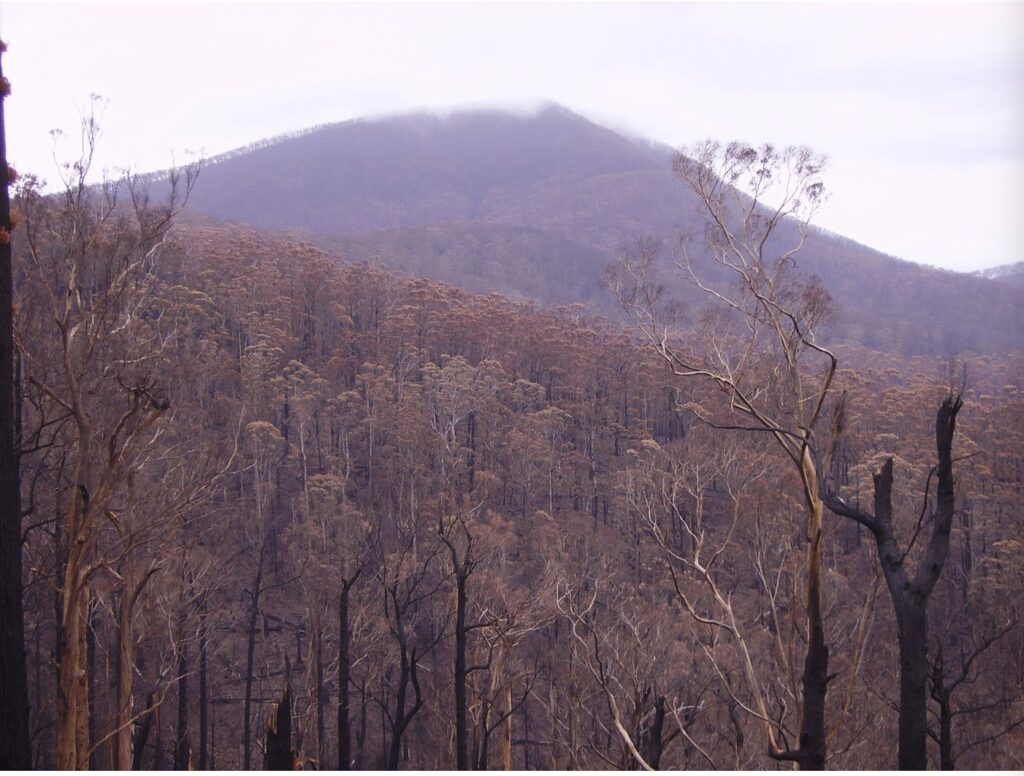
With the mature trees in generally poor health and setting little or no seed, NPWS planted a massive 23 seedlings in 2011 to try and save the decline.
Prior to 2019-20 Black Summer, the estimated population of mature mallees was 80 in less than four square kilometres of Mount Imlay National Park.
(Left) The devastating 2020 Border crown fire over Mount Imlay. Photo courtesy Joanne Korner.
The Border fire of 2019-20 affected the park when a run of the high-intensity fire on 4 January 2020 burnt out Mount Imlay.
A site visit in May 2020 confirmed the fire killed the remaining mallees but the latest publicly available information states there are now 48 mature mallees after the fire, despite occupying a sheltered aspect of the mountain. The surviving mallees were resprouting from their lignotubers. The fire also destroyed the adult plants of the guinea flower and boronia.
In August 2021, botanists had to collect 60 seedlings of the guinea flower and boronia to be planted back on site. Despite this, NPWS called it a positive post-fire recovery.
The mallee is one of 100 priority threatened species targeted for recovery. However, what is alarming is that no one knows anything about the reproductive ecology of the mallee, despite 50 years of being in a reserve, given priority status for saving, and over ten years of being listed as critically endangered. No naturally regenerated juveniles have been observed since the plant’s discovery in 1977.
(Right) The fire burnt out the top of Mount Imlay. Photo taken 5 September 2020. Photo courtesy Joanne Korner.
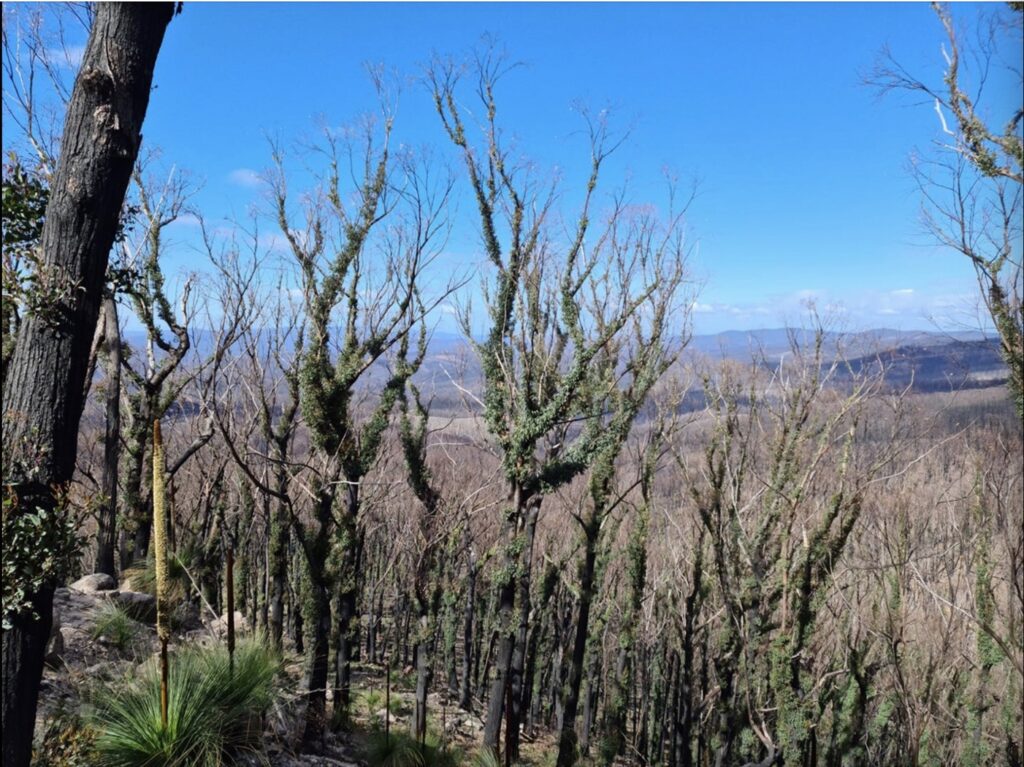
Natural establishment of the mallee from seed is an infrequent event, which is not surprising given the ground litter layer and heavy mulch where it occurs (see photo below). NPWS should prioritise low-intensity patch burning or manually remove the fuel among the mallees to create a seed bed in the event mature trees produce any viable seed.
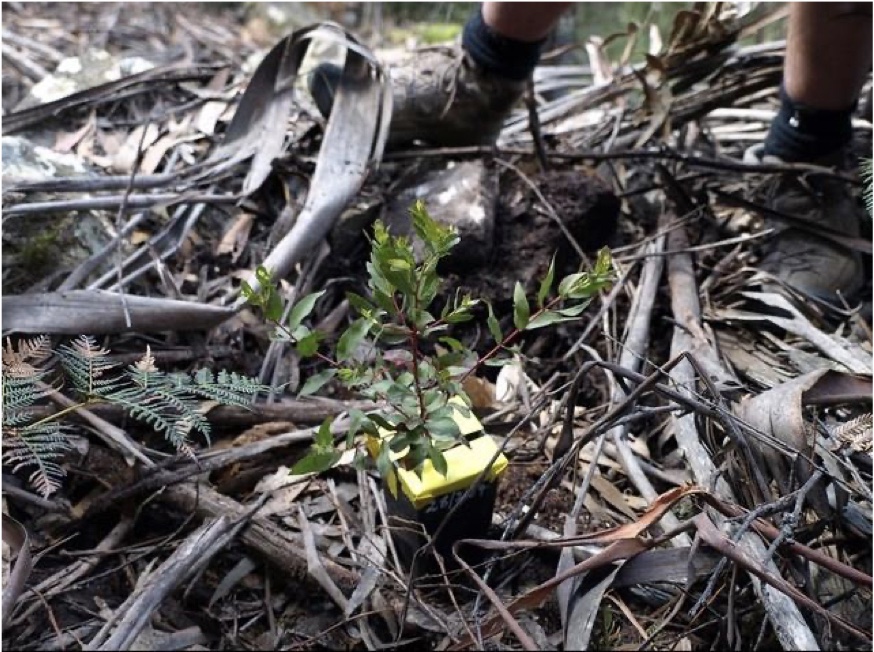
A 2020-21 report card by the New South Wales Government claimed there was good regeneration of the mallee after the fire, but they acknowledge that it will take at least a decade for any tree to produce seed. There are now many seedlings of silvertop ash (Eucalyptus sieberi) which was previously rare on the mountain, and tea tree (Leptospermum scoparium) that will have to be thinned “in the coming years”. Given the lack of appropriate active management on other reserves in the country, and the total lack of any active management on Mount Imlay in 50 years, I am not confident NPWS will carry out this work. Time will tell.
There is no doubt the outlook for the Imlay mallee is very bleak particularly if NPWS continues to have a pervasive cultural indifference to active management programs. So much for “permanent protection” offered by our parks and reserve system.
The helmeted honeyeater and Leadbeater’s possum
In Victoria, the Yellingbo State Wildlife Reserve in the Yarra Ranges was declared in 1965 to support the only known population of Victoria’s bird emblem, the helmeted honeyeater (Lichenostomus melanops), following representations made by local ornithologists. In 1986, Victoria’s mammal emblem, the lowland version of the Leadbeater’s possum (Gymnobelideus leadbeateri) was also found in the reserve, adding to the conservation value of the area. The habitat for the possum at Yellingbo was different to its core range in mountain ash (Eucalyptus regnans) stands of the Central Highlands.
Yellingbo contains mountain swamp gum (Eucalyptus camphora) country with a dense sedge understorey. Leadbeater’s possums rely on hollows in large gums for nesting and a continuous canopy of mid-storey or overstorey to move through their range in search of food.
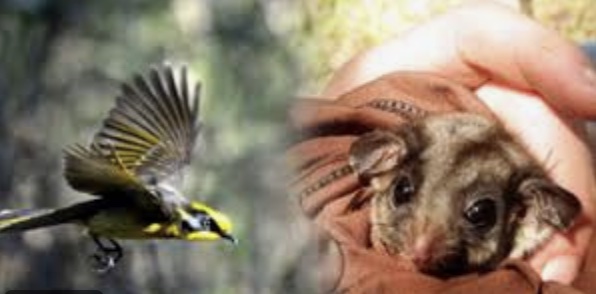
The helmeted honeyeater and Leadbeater possum.
Monitoring of the helmeted honeyeater occurred in the 1970s and 80s. Managers believed protecting the habitat from any use was important for the honeyeater as it would prove to be a vital remnant in a cleared agricultural landscape. However, the honeyeater population declined, with fewer than 40 adults remaining in 1987. Researchers at the time believed “protection of existing core habitat and replanting of cleared areas” was required.
Meanwhile, several adjoining areas were acquired by the Government through purchase or donation. In 1994, the Victorian Land Conservation Council recommended that most of these new areas be consolidated and called the Yellingbo Nature Conservation Reserve. Since then, further small parcels of land have been added to the reserve.
Well-meaning local conservation groups undertook annual revegetation works in the reserve. However, they excluded fires for many years, and the habitat quality aged, particularly the overstorey trees which senesced, died and fell over in the early 1990s. In addition, they mistakenly believed that the honeyeater required the shrub understorey for nesting. The bell miner (Manorina melanophrys) also swamped the area, a strong indicator of an ecological imbalance. Even though culling operations were carried out, it was only treating the symptoms and ignoring the cause of the honeyeater’s demise.
Due to the thick understorey of grasses, rushes and sedges, there was no recruitment or regeneration of mountain swamp gums. Rather than opening the understorey through controlled burning or mechanical disturbance, the conservation groups continued planting gums and mid-storey plants between 2009 and 2012 in the hope they would survive and provide the necessary habitat.

The amount of money directed towards Yellingbo is staggering, but it has done little to improve the habitat, nor has it stopped the decline in the two species it is supposed to protect. It is a classic case of monitoring to extinction without purpose. In an assessment of the uncoordinated work of the environmental groups at Yellingbo, a former ranger had this to say:
“Many projects, efforts and techniques used have been lacking in well thought out, investigated, known, trialled, or proven techniques – just random ideas, scattergun. Many failures have not been acknowledged, some actively suppressed (to save face or perceived insult), and the worst possible results of this action has been realised in that the valuable lessons that should have come from these failures have not been learnt and some failures have been repeated…We must stop individual agencies from taking off on irrelevant tangents, wasting substantial resources…We must shed unnecessary and unwieldy bureaucratic processes so we can make progress”.
He went on to offer solutions, but because his critique outlined bureaucracy’s failures, they were ignored and he is no longer a ranger. By 2018, it was not surprising to learn that only a few tens of hectares of this critical habitat remained in a deteriorating condition. The possum numbers crashed to around 20, mainly males. The helmeted honeyeaters now must be bred at Healesville Sanctuary with the Yellingbo Tufted Honeyeater to avoid an “inbreeding crisis” as part of an unusual and costly $30 million attempt at genetic species rescue. The local name for the cross-bred is the “Helmeted Moneyeater”. The birds are also supplementary fed at Yellingbo to survive. For a much cheaper result, all they have to do is actively manage the reserve to ensure the mountain swamp gum remains healthy.
The situation isn’t much better for the lowland Leadbeater’s possums. Numbers in the reserve also declined to about 20, mostly males. Meanwhile, the possum is thriving elsewhere in the state in regrowth state forests subject to logging and burning. Since 2014, VicForests’ field workers found 535 new Leadbeater’s possum colonies in post-logging surveys consisting of three to eleven individuals. They included possums in regenerating areas as soon as six years after logging or bushfire if there is a nesting habitat. Researchers found the possum far more resilient and numerous than expected before 2014.
Further, another study detected six Leadbeater’s possum colonies living in mixed-species forests up to 15 kilometres outside their previously known range in mountain ash forests and snow gum woodlands. For these reasons, the forestry sector has railed against efforts to portray Leadbeater’s possum as exceedingly rare and a lever to close the timber industry.
VicForests’ scientists spend many late nights in the forest using head-mounted spotlights and thermal cameras to observe species such as the Leadbeater’s possum in state forests. The thermal equipment has been a real game-changer for monitoring animal species, especially those that are difficult to observe through conventional spotlight surveys, allowing the scientists to better understand where these animals choose to find a home.
Leadbeater’s possums were not only discovered foraging in young post-harvesting regrowth but were also found nesting in silver wattle. However, this reality did not stop Professor John Woinarski from providing expert opinion on behalf of Friends of Leadbeater’s Possum in the celebrated court case against VicForests in 2020. He told the court that protection zones created for Leadbeater’s possum were ineffective as he believed forestry operations impacted the possum’s habitat.
VicForest night-time surveys prove how tolerant the possum is of VicForests’ operations. In fact, it is now acknowledged that the original research into the population status of Leadbeater’s possums has been overtaken by the work of VicForests’ scientists since 2014, which has found the possum to be far more numerous, resilient and widespread, including in habitat types where it had never before been known (see Table 1).
Table 1
The forest age cohorts and most recent stand-replacing disturbance events within the 1 hectare survey sites, and the number and percentage of sites with Leabeater’s possum detections in the Central Highlands, November 2014-April 2016. Data from VicForests.
| Last stand replacing event | Stand Age | No. of sites | No. of sites where LBP was detected | % of sites where LBP was detected |
| 1939 bushfire | 77 | 120 | 54 | 45% |
| 1983 bushfire | 33 | 39 | 23 | 59% |
| 1959-1977 timber harvesting | 39-57 | 17 | 7 | 41% |
| 1978-2005 timber harvesting | 11-38 | 36 | 18 | 50% |
| 1939 bushfire plus younger timber harvesting regrowth | 77 and 13-38 | 63 | 39 | 62% |
| 1939 bushfire plus older timber harvesting regrowth | 77 and 39-50 | 14 | 8 | 57% |
| Total | 289 | 149 | 52% |
Despite this reality, the TSSC provided conservation advice to the Federal Environment Minister to retain the Leadbeater’s possum as critically endangered. I respectfully suggest they partition the possum status as fine on professionally and actively managed state forests and as critically endangered on reserves subject to neglect.
Conservation agencies should also be forced to spend a similar amount of time and money surveying and observing endangered animals in their forests. They could then do the job they are paid to do – work out why they are declining and do something positive about it.
The orange-bellied parrot
The orange-bellied parrot (Neophema chrysogaster) breeds solely in south-west Tasmania and winters on the coast of southern mainland Australia, foraging on saltmarsh species, beach or dune plants and a variety of weeds. These areas are in reserves and they rely on them being well-managed for their survival.
Until the late 1970s, scientists knew little about the parrot outside local birdwatching circles. At the same time, Imperial Chemical Industries (ICI) announced plans to construct a petrochemical plant at Point Wilson at Port Philip Bay, close to an important over-wintering site for the orange-bellied parrot. This decision quickly exposed the lack of knowledge about the species and its vulnerability to extinction. To their credit, ICI funded research into the parrot’s population status, distribution, habitat selection and feeding ecology. While the petrochemical plant never went ahead, it provided the much-needed impetus to understand more about this enigmatic bird. In 1978, ecologist Richard Loyn also instigated annual winter population counts in Victoria, which formed the basis of a recovery plan.
Research on wintering habitats has revealed important knowledge about the feeding requirements and has even identified the use of sewage grass-filtration paddocks and golf fairways as a food source. Since the 1990s, most of its winter habitat area has been within conservation reserves, but incomplete knowledge of vegetation dynamics has hindered adequate management and rehabilitation of that habitat.
Despite all this positive work understanding the bird’s biology and reserving its winter and summer habitats, the experts estimated the parrot was about to disappear for good in 2016-17 and was ranked second as the most likely bird to go extinct. That summer, only 17 individuals made it to their Tasmanian breeding grounds. The experts blamed fragmentation and degradation of its winter habitat, introduced predators, disorientation from brightly lit fishing boats (I kid you not) and disease.
Because the parrot is a ground feeder, it needs open ground to see and get to the food. At its breeding grounds, they struggled to feed on a suit of herbs crowded out by old-growth button grass and other shrubs that were allowed to proliferate without regular burns. However, some recent prescribed burning stimulated their food source, and during the summer of 2022-23, high numbers of orange-bellied parrots returned to Tasmania.
Why has it taken this long for the Tasmanian Parks and Wildlife or the World Heritage Committee to consider fire management of its core feeding area to prevent a decline in orange-bellied parrots? Particularly since a conference paper summarising the recovery plan work since 1979, and published in 1990, stated: “a suitable fire regime must be implemented to promote growth and seeding of food plants” for the parrot.
The forty spotted pardalote
The forty-spotted pardalote (Pardalotus quadragintus) is one of Australia’s rarest birds. It is only found in Tasmania and has a restricted range, exclusively dependent on the sap exudate called manna from the young shoots of white gum (Eucalyptus viminalis) trees. Many of the stands of white gum favoured by forty-spotted pardalotes have declined in health and now have sparse canopies with few young shoots, hence the bird’s decline. And the leading cause of the tree decline is the explosion of biomass in the understorey. A survey in 2009-10 showed the population had declined by 60 per cent after a previous study 12 years earlier, despite their habitat being well-protected.
The “experts” associated with government agencies were baffled over a sharp decline within an intact habitat. They predictably blamed the destruction of white-gum forests and climate change as the culprits. These “experts” conveniently ignored, or did not know, that white gums only produce manna when they have a healthy, dense canopy and are actively growing.
(Right) Forty spotted pardalotes using wooden nest boxes on private property.
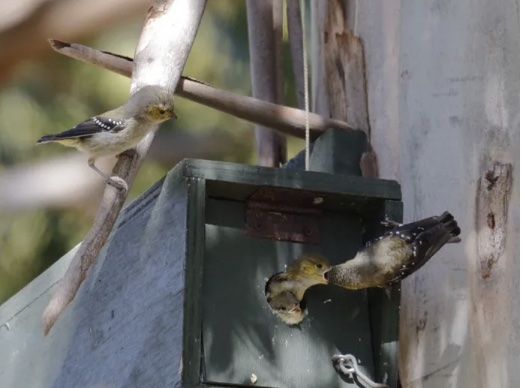
They also had no idea how vital tree hollows are for their nesting, mainly as they compete with the larger striated pardalotes, who also have a greater capacity for sustained flight. Researcher Max Edworthy found that a lack of suitable nest hollows was a critical factor during his PhD work. Even though they can expand existing holes at hollow entrances with their small beak, it can be difficult when they compete with the larger striated pardalote for ownership of the hollow. Edworthy, to his credit, implemented a pragmatic strategy of installing 100 nest boxes on Bruny Island as part of his study and, by 2012, found 27 forty-spotted pardalote pairs using the boxes.
The forty spotted pardalote is thriving on a private property in the southern part of Bruny Island. As part of running a successful ecotourism business, the landowner has planted white gums, actively managed the stand of trees and provided wooden nest boxes in the young regrowth stands. In addition, they mechanically remove any build-up of biomass and fuel around the base of mature trees. This practice contrasts with other unmanaged stands of white gums that used to support healthy populations of pardalotes.
Interestingly, Australian National University researcher Fernanda Alves also discovered another threat to the birds. She found parasitic flies laying eggs in the nests of the pardalote were killing them. She developed a feather dispenser for the birds to build their nests and remove flies. Over 100 dispensers were made before the last nesting season to help save the endangered bird.
However, the Tasmanian government conservation agency still blindly maintains that the loss and degradation of habitat threaten the bird through clearing. It is a pity the government holds onto predictable perceived threats which have nothing to do with the actual danger. With this draconian attitude, how can the public have any confidence they know how to protect endangered species?
Forty-spotted pardalotes will continue declining on public reserves because “experts” blame esoteric problems such as climate change and habitat destruction. Their inability to acknowledge other problems that are of their making, and develop pragmatic solutions, highlights a lack of practical land management experience which is crucial in managing endangered species in reserves.
The southern brown bandicoot and long-nosed potoroo
Population figures show the southern brown bandicoot, near Eden, has declined in forests that have been transferred from state forests to national parks. But their numbers have increased in nearby regrowth state forests. Despite listing the impacts of timber harvesting as a major factor, the TSSC has had to acknowledge that East Boyd, Nadgee and Yambulla State Forests near Eden, form part of the stronghold for the south-eastern population in New South Wales.
Consequently, to the horror of local environmental activists, NPWS have relocated healthy bandicoots from the regrowth state forests south of Eden to populate Booderee National Park, dedicated in the first place to protect these species.
They may have to do the same operation in other reserves. The TSSC report of May 2016 outlined the status of the bandicoots. The report assessed all the available quantitative estimates for population trends which showed a 50 per cent reduction in bandicoot numbers over ten years in parks and reserves in New South Wales, Victoria and South Australia (see Table 2).
Table 2
Available quantitative data on southern brown bandicoot status in reserves
| Population location | State | Decline |
| Ben Boyd National Park | NSW | 44 per cent (199 to 2008) |
| Nadgee National Park | NSW | 47 per cent (1999 to 2008) |
| Port Campbell | Victoria | >70 per cent (2010-2020) |
| Pines Flora and Fauna Reserve | Victoria | 100 per cent (extirpated around 2006) |
| Mt Lofty Ranges (nth metapopulation) | SA | 100 per cent (extirpated around 2009) |
In 2004, planning commenced to repopulate Booderee National Park with long-nosed potoroos that had once flourished in the park. Staff from Environment Australia, Australian National University, Taronga Zoo and Forestry Corporation of NSW worked together to carry out this vital translocation project. Ten years later, the first translocation occurred from animals captured in state forests in the Eden area. It is nearly 100 years since the long-nosed potoroo and southern brown bandicoot can call Booderee National Park home again. The animals are radio tracked and are doing well in their new home. So much so, the first bandicoot born in Booderee National Park in almost a century occurred one year after its mother relocated.
How ironic it is to see healthy endangered animals flourishing in actively logged regrowth forests the environmental activists have always claimed were a major threat. The Forestry Corporation of NSW is leading the way in managing endangered species on the far south coast of New South Wales by adopting a rational approach to assessing the critical threats. Among them is an effective predator control program that has been in place since 2007 for over 100,00 hectares of state forests. The decision to change from a seasonal baiting program to permanent bait stations has also paid dividends.
As a result, ecologist Peter Kambouris has recorded significant increases in populations of small mammals, including the endangered southern brown bandicoots and long-nosed potoroos. The latter were one of the first species to respond positively to the changed baiting program. Peter and his team monitor the populations with 120 remote cameras, with bandicoots and potoroos being detected at more sites.
Curiously, the population recovery of the southern brown bandicoot on state forests was not used in the TSSC advice to the minister. Instead, they relied on data over eight years old from NPWS. It begs the question, what program had NPWS carried out in the years prior to 2016 to address the southern brown bandicoot population decline, and if the declines actually had been reversed on national parks, why was old data used? How long can the bureaucrats and governments ignore the successful work of Forestry Corporation of NSW in managing endangered species on state forests compared to the poor performance in adjoining national parks?
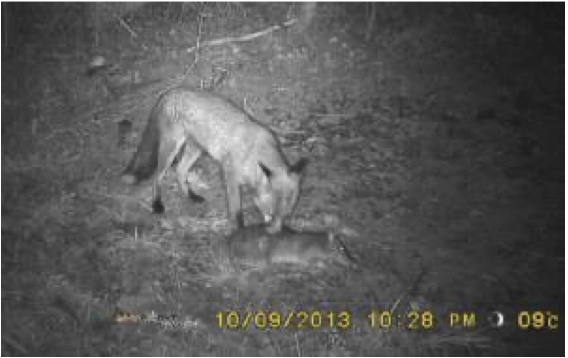
The greater glider
Greater gliders (Petauroides volans) have recently received much focus, mainly from environmental activists hell-bent on halting logging in native forests. If they were really concerned about the gliders, they would focus all their attention on what is happening in reserves set up to protect this arboreal mammal, especially Booderee National Park near Jervis Bay. Being on Commonwealth land, the Federal Government manages the park. The species formerly occurred in the park, but they have become extirpated under their watch, which means they are locally extinct. Instead of pushing to reserve 30 per cent of land in the country, Environment Minister Tanya Plibersek should focus on lands under her responsibility and get her house in order first.
It is not just at Booderee where the greater gliders are disappearing. Eighty-four per cent of the glider’s habitat was burnt in the 2019-20 wildfires in the Greater Blue Mountains World Heritage Area. Consequently, monitoring has revealed a steep decline in subpopulations within the park. Even scarier is that these recent declines suggest that many unmonitored subpopulations of the greater glider are likely to be declining.
Management of the Blue Mountains area has been a problem for decades. At an event in the Blue Mountains, the former New South Wales Environment Minister, Matt Kean, told the media it was necessary “to leave our planet to our kids better than we found it”. However, less than a week later, the International Union for Conservation of Nature (IUCN), the official adviser to the United Nations Educational, Scientific and Cultural Organisation (UNESCO), downgraded its rating of the Greater Blue Mountains World Heritage Site to “significant concern”. In just 20 years, the site has gone from one with outstanding universal value to the second lowest rating there is. It is hardly the performance that gives confidence to our kids that they are inheriting an environment in better condition.
The Australian Conservation Foundation claims the glider is threatened by “land clearing and forest destruction” but would never countenance the decline could be due to a lack of proper management in our reserves.
Similarly, the Sydney Morning Herald’s environment reporter listed logging first and bushfires second as contributing to the decline of greater glider numbers. He quoted Professor David Lindenmayer:
“But selective logging has changed the composition of forests, particularly around Eden on the NSW South Coast and in north-east Victoria, and they are now dominated by tree species that gliders can’t eat”.
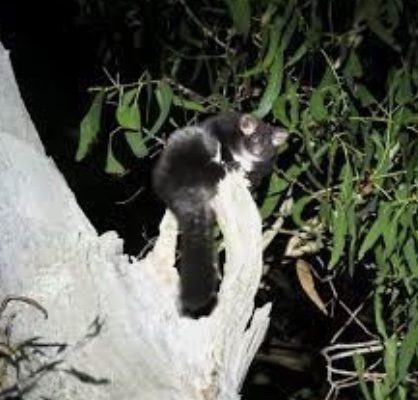
(Left) Surveying for greater gliders.
However, recent surveys provide data that challenge the logging impact hypothesis. VicForests’ forest scientist, Michael Ryan, has highlighted that fauna surveys on state forests in Victoria show a high prevalence of greater gliders after harvesting operations. In addition, post-harvest fauna surveys clearly show VicForests’ harvesting and regeneration practices are much better at protecting Victoria’s wildlife, as endangered species are now commonly found immediately within or around completed harvest areas. Mr Ryan said:
“Since mid-2019, we have been using variable retention harvesting systems which, at its core, means that we better accommodate for wildlife in or next to each harvest area. We carefully balance our economic and environmental requirements by ensuring suitable habitat is retained and maintaining forest connectivity. This has seen species such as the Greater Glider being detected in or around most of our completed harvest areas where they were found pre-harvest, and the preservation of suitable habitat trees and future habitat trees also allows for other hollow dependent species to use these sites.”
A report published in May 2018 examined the status of the greater glider in the Strathbogie State Forest in north-east Victoria. It found high numbers of gliders, with estimates of 69,000 in a forest where timber harvesting has occurred. However, this didn’t stop local activists claiming selective harvesting creates a forest dominated by tree species with leaves the gliders don’t like to eat.
So, exactly what is the state of Strathbogie State Forest – a selectively harvested forest with 69,000 starving gliders or a thriving community of 69,000 gliders that must be protected from logging of trees whose leaves the gliders won’t eat?
The Herbert River ringtail possum
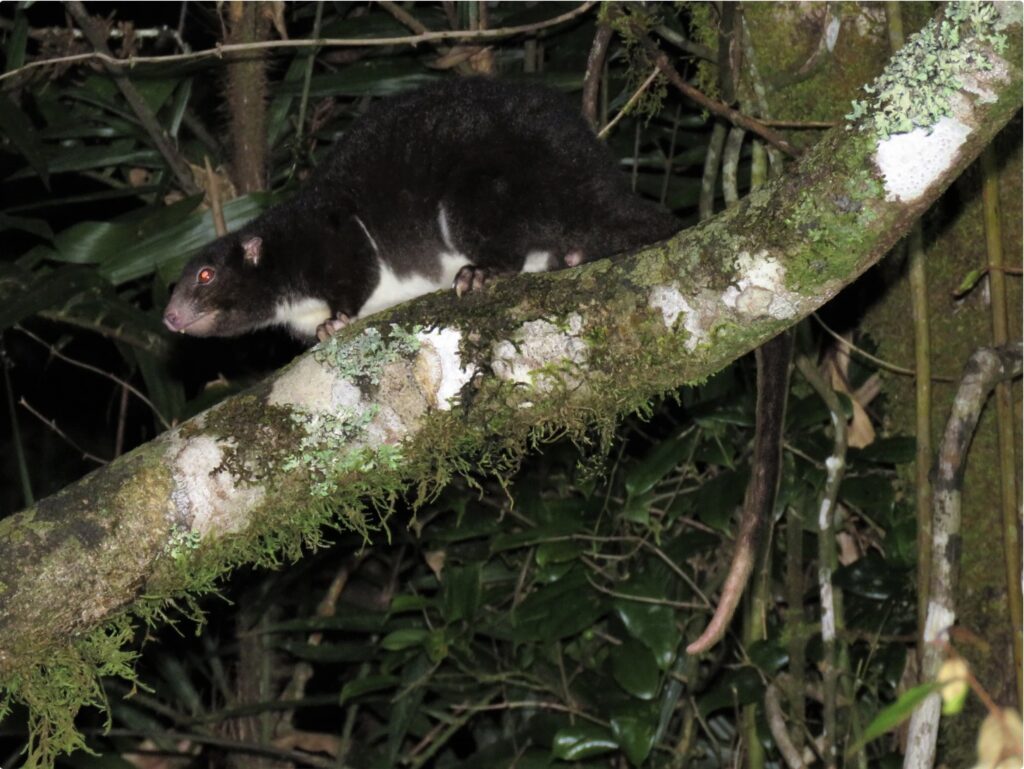
Researchers and rangers have been searching for declining Herbert River ringtail possums (Pseudochirulus herbertensis) in the misty mountain peaks of far north Queensland. Their lack of success is blamed again on the convenient get-out-of-jail card called climate change. They haven’t seen a possum in a decade. Newborns are not replacing the dying possums, leading to a long-term decline.
(Left) The Herbert River ringtail possum.
Amateur ecologist Jimmy Lamb spent some time visiting Queensland. He documented his spotlighting visits to the Southern Atherton Tableland uplands, where he observed several Herbert River ringtail possums on the private property interface. In one example, he saw one:
“…wolfing down leaves in a tree near the carparking area. I was really tickled because this possum, perched on the branch enjoying dinner, looked for all the world like a giant contented budda”.
In 1983, ecologists accused selective rainforest logging of reducing the numbers of Herbert River (and Lemuroid) ringtails. However, it isn’t a canopy-dweller and uses the ground to move around. Rainforest logging stopped not long after that accusation, so why hasn’t the Herbert River ringtail recovered? The undeniable fact is that well-protected ringtail possums are disappearing in reserves that have nothing to do with harvesting the trees.
More disturbing, Queensland Parks and Wildlife Service rangers at Tinaroo are also witnessing the disappearance of mammals, birds, reptiles and invertebrates that usually inhabit the mountain peaks. For example, the spotted-tailed quoll (Dasyurus maculatus) population on the Lamb Range is down to just a handful of individuals. Locals believe the primary reason for many native species disappearing or declining is that rangers are not managing the reserve to prevent severe fires in their natural habitat. They say the same animals happily co-exist on adjoining actively managed grazing lands with remnant patches of rainforest.
It is good to see prescribed burns introduced and planned to be carried out regularly in recent years. But time will tell if that makes a difference to the alarming decline in native animals.
River red gums
In 2005, the New South Wales government purchased Yanga Station, near Balranald in southwest New South Wales, to reserve as a national park. It supports about 17,000 hectares of river red gum (Eucalyptus camaldulensis) forest, including 150 kilometres of river frontage on the Murrumbidgee River. The NPWS finally opened the southern part of the park to the public in 2009. The rest remains closed to the public, locked up and declining under benign neglect.
Bob Carr, then Premier of New South Wales, commended the owners and managers of this property for the excellent care of the forest. The Department of Environment also openly acknowledged the superb condition of the forest and its environmental values, despite the prolonged drought at the time. However, Carr still believed it was better served as a national park.
Sadly, Yanga Station, once Balranald’s jewel on the river, is now a shadow of its former self. At the time of the purchase, Carr assured concerned locals not to worry about the health of the beautiful red gum forests because NPWS and the Department of Environment, Climate Change and Water knew how to look after the forests.
Environmentalists and experts claim that the red gum forests on Yanga are the most significant extent of native forest in the area. However, they ignore history, which shows the forests are an artefact of European settlement. In 1900, early written descriptions of the property described the Yanga floodplain as supporting an open grassy woodland. But that changed in 1940 when the Redbank Weir was constructed on the Murrumbidgee River. It released the flow of water onto the Yanga floodplain, and before long, a river red gum forest was born.
After a decline in the wool industry, the Yanga Station owners managed red gums sustainably to produce sawlogs. Timber from the forest supported a local mill and provided many jobs in Balranald and the surrounding area, offering a sustainable livelihood for numerous families. The property paid rates to the Wakool Shire. Most businesses in Balranald also depended on Yanga.
The government brought to an abrupt halt sustainable and active management at the cost of more than $35 million to New South Wales taxpayers. All the jobs have gone, businesses are struggling, and the local community has suffered. NPWS abandoned previous water management works and specially provided environmental flows are allowed to run off and are wasted. There are thousands of hectares of dead trees and fallen timber. There are reed beds, cane grass and bull rushes over a foot high. Burrs and box thorns have infested large areas.
NPWS have spent millions of dollars on a big shed and renovating the 1870 homestead, bringing the materials from other areas, and a few jobs from other towns have been created. Yet locals who have visited the heritage buildings report they are rapidly deteriorating.
But when concerned locals have raised questions with NPWS about poor management, dying trees, fire hazards and insufficient funds, they are arrogantly dismissed and told nothing can be done and to put their concerns to an advisory committee. But the details of the committee remains a secret. Apparently the closest member of that committee lives 300 kilometres from the park. The locals believe the park is operated on a shoe string budget where rudimentary management needs are not carried out.
Today, Yanga Station supports hundreds of thousands of dead and dying river red gums, covering about 60 per cent of the forest. One local has told me the park is “locked and loaded for the biggest barbeque in New South Wale’s history”. NPWS ignores this and proudly boasts on its website it has “management strategies in place to protect and conserve the values of the park”. However, even the 2009 Natural Resources Commission Preliminary Assessment Report found that the forests are “likely to continue declining and …are in need of…active silviculture”.
Policies are not reviewed and there is no strategic plan to address the threats and risks facing the park. According to locals who have tried to deal with NPWS, funding cuts have restricted field officer’s ability to acquire skills and look at alternative means of managing the threats of bushfires and pests. Since becoming a national park, NPWS stand aloof, alone and totally isolated in the local community. So much for Carr’s empty promises. When it comes to the environment, never trust a politician and never believe their promises.
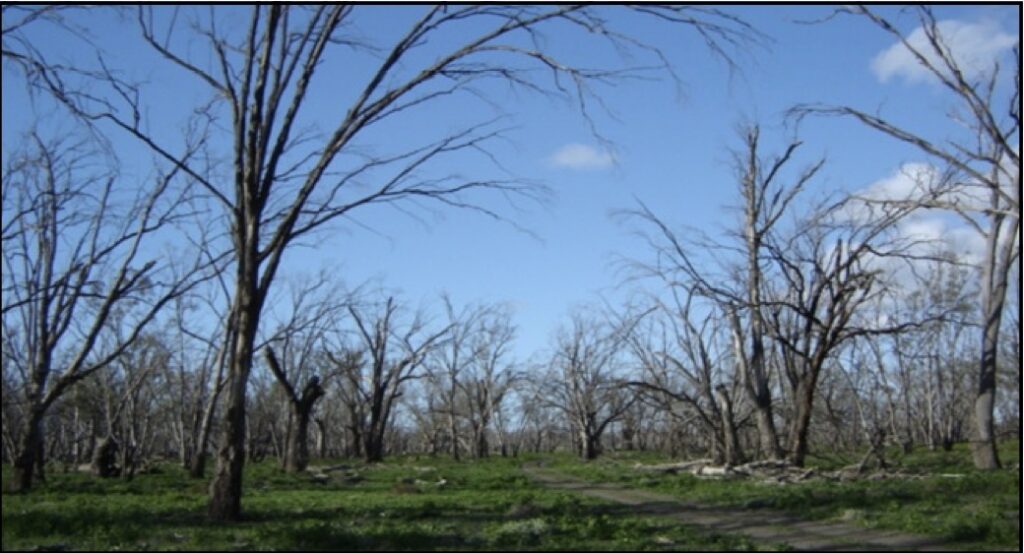
Since European settlement, it is now one of the most prominent examples of killing trees on a single property. The NPWS blames the situation on drought. However, the privately-owned forest across the river is managed as a healthy, sustainable, productive business that boasts credible environmental outcomes and supports healthy river red gums.
Management by the Forestry Commission over many decades and through previous droughts has proven that river red gum forest health depends on active management. Silvicultural thinning is crucial. Benign neglect by NPWS has simply proven that they cannot look after these forests. Active management must return to Yanga National Park before it all dies.
(Right) Healthy red gum forest on adjoining property. Photo Andy Millar.
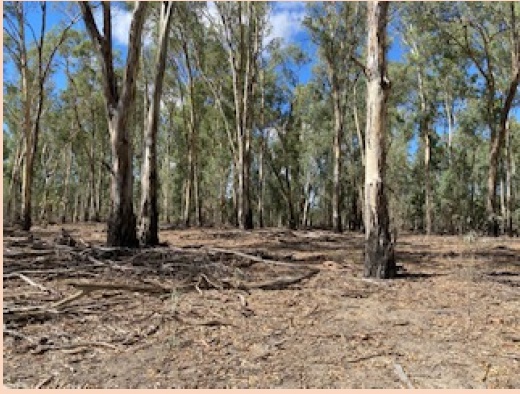
Why does the government continue buying land to expand the national park estate and burden the NPWS with new responsibilities when it desperately needs money to manage existing parks? They need to listen to concerned locals and adopt their suggestions of opening the park to business opportunities and focus on revenue rather than propaganda so that the land can be actively managed and the environmental degradation problems addressed. The only way forward to achieve sustainability is to manage the park progressively, not regressively.
The southern corroboree frog
The terrible loss of the southern corroboree frog’s (Pseudophryne corroboree) entire “protected” colonies is undoubtedly a metaphor for the failure of benign neglect in our parks and reserves. Unfortunately, being an iconic amphibian species and amongst the most visually spectacular frog in the world, with bright yellow and glistening black stripes, means nothing to the agency responsible for its management and survival. Critically endangered, there were reports of only 50 to 200 frogs left in the wild before the 2019-20 Black Summer fires.
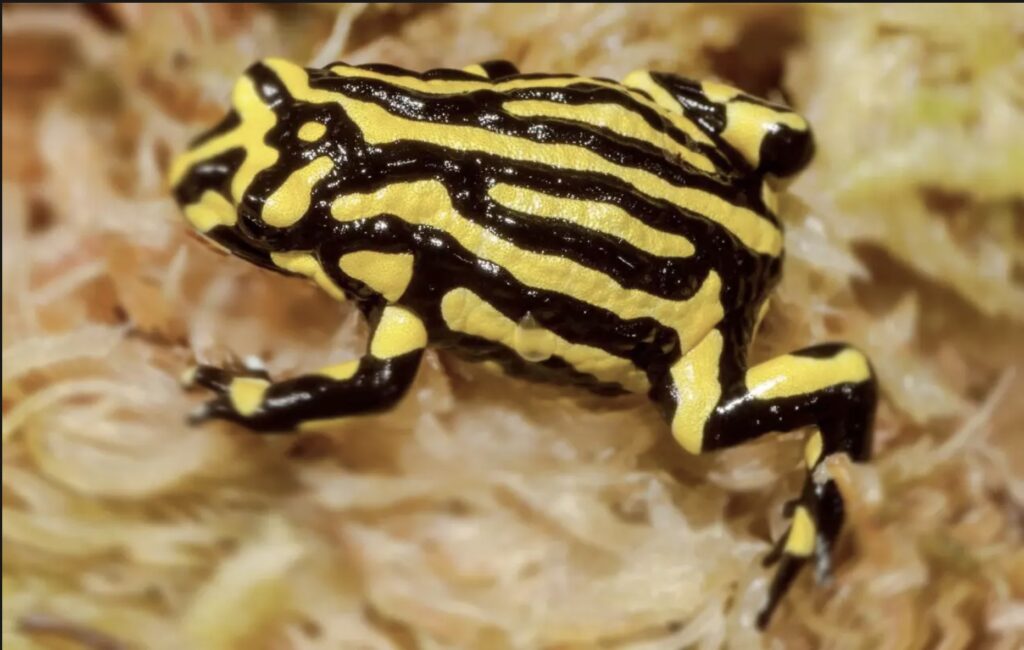
Just before Christmas in 2019, 115 corroboree frogs were laboratory-reared at the University of Wollongong as part of a breeding program to save the dwindling numbers from extinction. They were helicoptered into Kosciuszko National Park, where they were delicately and individually introduced into custom-built enclosures to protect them from the chytrid fungus that had decimated numbers in the past.
Weeks later, fierce bushfires bore down on the fledgling colonies. Two fronts converged on the remote and inaccessible sphagnum bogs. By not actively managing the surrounding fuel loads, the corroboree frog was nearly extirpated from a park that was supposed to protect it.
Instead of being proactive and implementing fuel reduction cool burns across the whole park to minimise the risk of massive conflagrations, NPWS made sure we bore witness to the virtual loss of a beautiful frog species. The fact they spent so much on a carefully orchestrated breeding program and exposed the frogs to a brutal death by not protecting its habitat from fire at the end of a prolonged drought, says much about their lack of priorities and competence as land managers.
Thankfully, after the fires, 40 frogs survived, so there is still hope. However, we can only sit back and anxiously wait for something to be done to reduce the likelihood of large conflagrations in Kosciuszko National Park in the future.
Critical breeding habitats for the frog are sphagnum bogs, and many were burnt. For example, marshes near McNamara’s Hut at Dinner Plain and south-west of Kiandra near Mount Selwyn were destroyed and allowed to burn to bare earth through neglect. This truly is an unprecedented event in terms of fauna (mis)management. Human stupidity allowed the unnecessary cremation of hundreds of hectares of the vitally essential sphagnum bogs and virtually kill off the last remaining populations of the corroboree frogs.
In March 2023, it was reported that another 100 corroboree frogs were again released into the park in “disease-free, purpose-built enclosures”. The department had the gall the claim the “success of this long-term project”. I guess if you ignore allowing just about every fire-sensitive sphagnum bog in the park, a vital habitat for the frog, to be forever destroyed, then you might be able to get away with calling it a success. Time will tell how the frog survives without its critical habitat.
The little penguin
I can’t write this story without mentioning the endangered little penguins (Eudyptula minor). The communicable tumour disease was a genuine concern to Tasmanian devil populations (Sarcophilus harrisii) early this century, in the state’s eastern half, as numbers of the devil rapidly declined. As a result, researchers and the government decided to institute safeguards to protect the species. One idea was to introduce healthy devils to a deviless Maria Island off the east coast in November 2012.
However, showing myopic vision on just the devil, no one gave any thought to a possible cascading effect. As a result, one of Australia’s boldest ecological interventions went horribly wrong for some species, with the new devils wiping out the little penguins and hammering other seabirds.
Bird experts warned against the experiment, predicting the devils would have a significant impact because they had never lived on the island. Surveys in 2010-11 found 3,000 breeding pairs of little penguins across the island’s four breeding colonies. According to BirdLife Tasmania, all the penguins are now gone.
A 2001 government risk assessment of the devil introduction noted that “direct impacts of the penguin population by devil predation is expected”. In 2012, Birds Tasmania and the Tasmanian Conservation Trust pleaded with the government not to proceed with the translocation of the devils, citing likely significant negative impacts on other species.
They claim the killing of the little penguins was predictable from day one. Sadly, we have witnessed yet another poor result for animals supposed to be protected in national parks. Tellingly, it could have easily been avoided. Still, the proponents of the devil translocation project went ahead anyway, and now accountability for the slaughter must be taken by those responsible.
Here is a stark example of a conservation agency and other guilty experts responsible for the wilful extirpation of an endangered species without any organisation or individual being held responsible. How can environmentalists, bureaucrats and experts ever learn from their mistakes if this tragedy is swept under the carpet?
The golden-shouldered parrot
The golden-shouldered parrot (Psephotellus chrysopterygius) is an endangered bird, nests in termite mounds and is found only in a small area of Cape York Peninsular in far north Queensland.
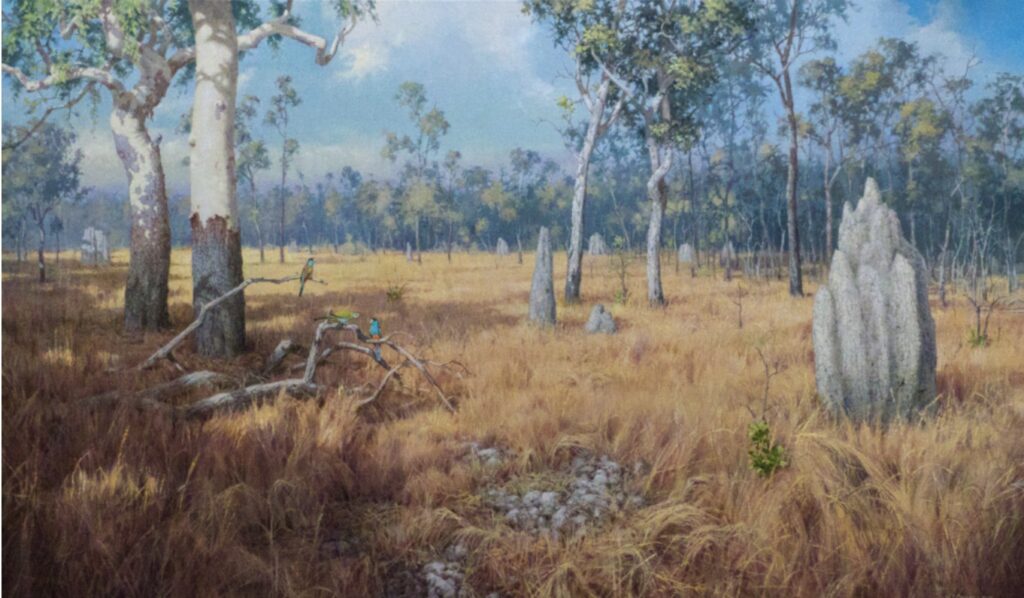
According to the ABC, the golden-shouldered parrot is on the brink of extinction. While the official narrative is that fewer than 1,500 are left, according to pastoralists, numbers are greater than a decade ago.
(Left) Beautiful landscape painting of by artist Bill Cooper of golden-shouldered parrots on Artemis Station.
And the owners of Artemis Station, Sue and John Shepherd should know, as they lead the way in monitoring and implementing active management to provide the environmental conditions to help the parrot survive.
Initially, scientists like Stephen Garnett were involved in an intense three-year research program on the parrot at Artemis in the 1990s. Once funds ran out, he had to abandon his work, but not before a 2,115-hectare nature refuge was declared on the property with burning discouraged.
The Queensland Environment Minister in 1998 described the work by the Shepherds as an outstanding example of multi-purpose land use, which integrated conservation objectives with pastoral production.
(Right) Golden-shouldered parrot.
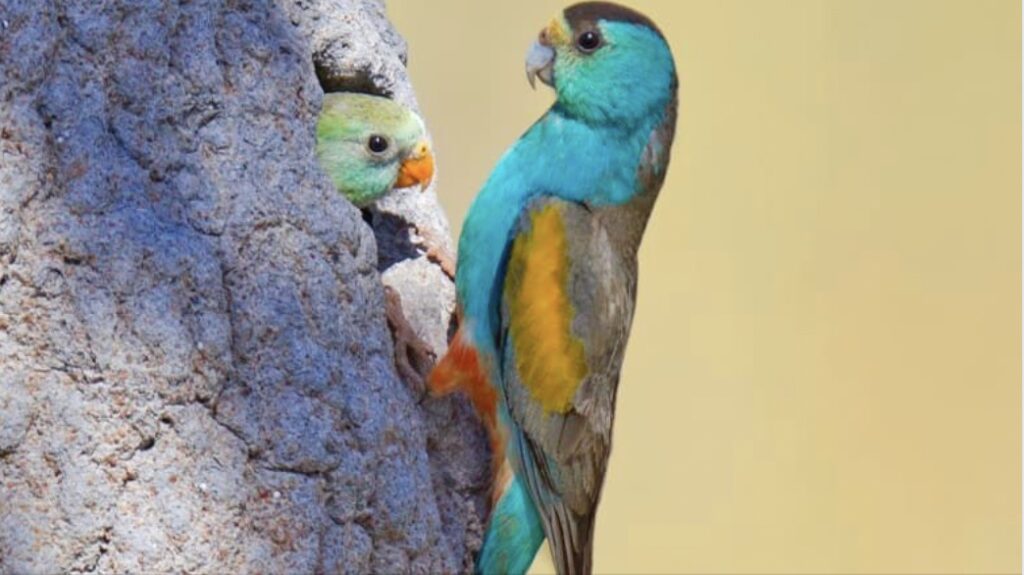
While Artemis once supported a thriving population of parrots, their numbers dived to about 50 earlier this century, not long after burning stopped. The Shepherds decided to do something to keep the parrot alive. They realised that the habitat for the parrot had become thick with trees and shrubs. Burning wasn’t required when cattle kept the grass down, but it didn’t stop the unchecked growth of shrubs and trees. This new ecosystem provided the cover for butcherbirds perched in a melaleuca tree, waiting for the young parrots to emerge from the termite nest. Unfortunately, the butcherbirds were also found predating on feeding birds during the wet season when the parrot had to spend more time on the ground trying to feed on scarce grass seeds. This made them more vulnerable.
To their credit, Artemis Station has instituted a program to restore 5,000 hectares of open savanna grassland and woodland by establishing a grazing regime that allows parrots and beef production to co-exist. They have also thinned or cleared thickened bush to recreate the open grassland in areas the parrots still occur in and sites they have abandoned. They then maintained the open structure by applying a specific fire regime and controlled feral predators such as pigs and cats.
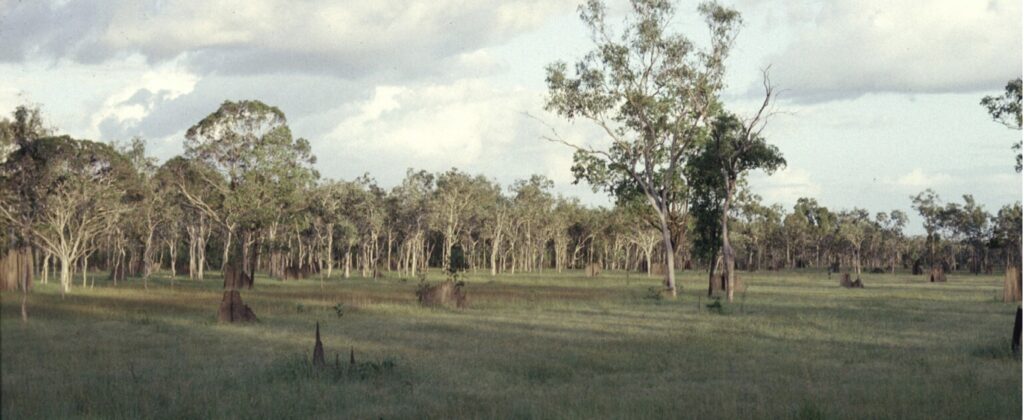
What is appealing about this work is the use of robust scientific methods by establishing a baseline study that measured butcherbird density, feral cat activity and vegetation cover. Then, as they restored habitats, they monitored those indicators against any recovery of the parrot numbers and made adjustments as necessary. A great example of adaptive active management.
The Shepherds rely on private donations and set up an enduring fund with some support from universities and the Australian government.
Wouldn’t it be wonderful for our endangered species if the governments, environmental agencies, and activists all shared the same pragmatic approach to species conservation that the Shepherds have shown? Instead of holding onto the myth of excluding all European activities from land use and blaming esoteric threats, our national parks and reserves throughout the country would support more endangered species. We can only dream that they would act like the Shepherd’s and change their management strategies when they find out their current methods are not helpful.
Wrapping up
The examples above provide a stark reality check about the nation’s obsession of placing millions of hectares of land into reserves and failing to manage them. Protecting species needs active human management, which has occurred for millennia in this country. To argue otherwise is to say that Aborigines didn’t exist and did not play any role in the make-up of our country before Europeans arrived.
The Labor government has promised no new extinctions and has already reviewed the Federal environmental laws. In his report, Professor Graeme Samuel highlighted what I have done above writing that our environment is in a state of decline. Unfortunately, Federal Environment Minister Tanya Plibersek has refused to acknowledge that the problem rests with environmental agencies’ abysmal management of our reserves and poor government funding. Instead, she maintains that the usual culprits are climate change, land clearing and habitat destruction, at the same time she promised the government would introduce a process to ensure habitat-destroying infrastructure, such as wind farms, will get rapid approvals to meet their politically-motivated renewable targets.
I read a recent study in the tropical rainforests of Borneo that shows harvested forests have similar or even greater ecological value than those left alone. The authors of the study point out that the perception that logged forests are degraded only serves to encourage clearing for palm oil plantations when they can instead provide a valuable ecological role, supporting “similar or greater densities of almost all birds and mammal species”. It is no different with the native forests in Australia that have a long history of harvesting trees.
I wish we had environment ministers in all states with a level of intelligence and awareness about the actual state of our environment and they were brave enough to stare down the media, activists, bureaucrats and academics who have unhelpful agendas. They can then fund and implement the appropriate active land management that is required to protect our biodiversity. The current ministers’ blinkered views and ignorance of the real causes will only see the status quo maintained. As a result, endangered species on reserves will be driven to extinction even though they have been set up to protect them. When will the penny finally drop that the “lock it up and leave it model” is not as successful at protecting endangered species compared to actively managed forests?
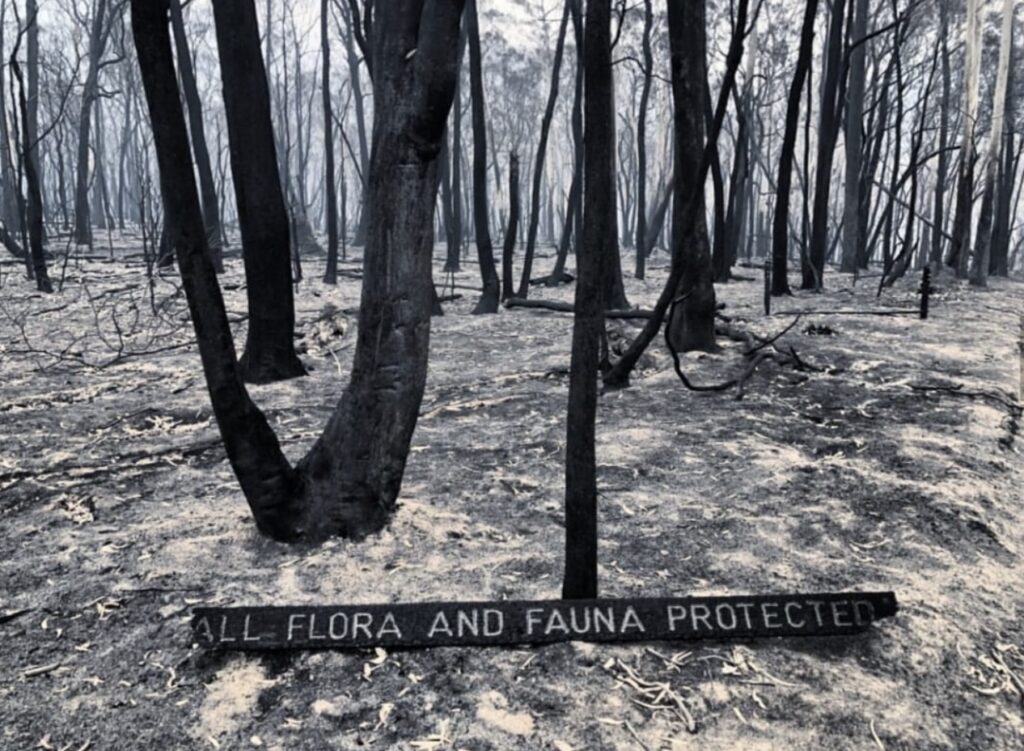
This article gives just a peek into the diversity of thousands of different ecosystems we have in Australia. Then throw in different climates.
All of this environmental diversity is managed by a simplified and politically advantageous legislation, managed by a simplified ideologically.
Neither are fit for purpose, but as your article has highlighted, systematic environmental failure goes unrecognised due in part to the wilderness myth which requires no checks and balances. It is a myth that National Park legislation immediately protects the environment, yet in effect, simply removes stewardship knowledge of that particular area and ecosystem.
We are told that 40,000 to 60,000 years of a human-evolved environment must now be changed to suit the short-term political aspirations that pays no price for being wrong. Incredibly politicians are usually rewarded with election success and their associated career ideologs gain more power and funding.
In 1971, Victoria had 205,000 hectares of Parks and reserves. Currently there are over 4,000,000 hectares and the CSIRO 2018 report listed bushfires and feral animals as the major threats of extinctions. No correlation or causation was offered as to the massive increase and change to ideological management to a huge area of Victoria.
Here is a similar story about the swift parrot – https://www.timberbiz.com.au/opinion-tim-payne-conservationists-are-killing-the-swift-parrot/
I don’t share his view about the link of the decline with climate change simply because there is no data that proves it is a cause – all he does is highlight a correlation.
However, the role of conservationists in dictating policy on restricting timber harvesting and ignoring the other reasons for the bird’s decline is yet another symptomatic problem with environmental management in this country, and proves it does nothing to help the species it is supposed to be protecting.
The problem with popular conservationists is that they are trying to force their particular view of the landscape, as they would like to see it, not knowing that the landscape is forever changing, sometimes quickly and sometimes in a longer cycle.
Now this is the question – who gives any one the right to force their particular view of a segment of history as the supreme form of any landscape and what lives within it?
Governments pathetic in handling our parks.